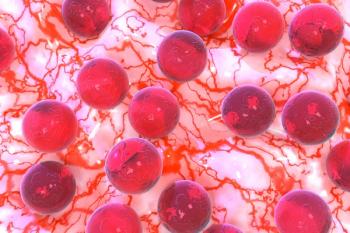
- ONCOLOGY Vol 24 No 7
- Volume 24
- Issue 7
Improved Understanding of Peripheral T-cell Lymphomas
Peripheral T-cell lymphomas (PTCLs) are rare and heterogeneous non-Hodgkin lymphomas that have been separated by clinical presentation, histology, immunohistochemistry markers, infectious agents, and genetic abnormalities. They may have extranodal dissemination and are often aggressive, especially when they express cytotoxic markers. The international T-cell Non-Hodgkin Lymphoma Study Group collaboration has highlighted differences in the frequency of these entities in different geographic areas.[1,2] For example, HTLV-1+ adult T-cell lymphomas are found in Japan and nasal NK/T-cell lymphoma occurs predominantly in Asian countries. The most common PTCLs are unique and not able to be classified by a specific marker or tumor antigen, and are known as peripheral T-cell lymphomas, not otherwise specified (PTCL-NOS).
Peripheral T-cell lymphomas (PTCLs) are rare and heterogeneous non-Hodgkin lymphomas that have been separated by clinical presentation, histology, immunohistochemistry markers, infectious agents, and genetic abnormalities. They may have extranodal dissemination and are often aggressive, especially when they express cytotoxic markers. The international T-cell Non-Hodgkin Lymphoma Study Group collaboration has highlighted differences in the frequency of these entities in different geographic areas.[1,2] For example, HTLV-1+ adult T-cell lymphomas are found in Japan and nasal NK/T-cell lymphoma occurs predominantly in Asian countries. The most common PTCLs are unique and not able to be classified by a specific marker or tumor antigen, and are known as peripheral T-cell lymphomas, not otherwise specified (PTCL-NOS).[2]
Systemic anaplastic large cell lymphomas (ALCLs) and the cutaneous CD30+ lymphoproliferative disorders are second in frequency among both the PTCL and the cutaneous T-cell lymphomas, respectively.[2] Querfeld et al have written an outstanding and very thorough review discussing the diagnosis and treatment of anaplastic large cell lymphomas (ALCLs), with emphasis on the systemic entities. In their introduction, the authors state that ALCL occurs as two distinct clinical entities-a widespread systemic disease or a localized (primary) cutaneous disease. As they indicate later in the article, however, this may be an oversimplification. For example, as reviewed by Savage et al, there are two distinct systemic forms of ALCL, with different overall survival curves.[3] Also, primary cutaneous ALCL (CALCL) has a wide clinical range, from small self-regressing papules to widespread disseminated tumors progressing to nodal involvement.
Classification of ALCLs
ALCLs are classified by large sheets of cells with high expression of the tumor necrosis factor (TNF) death-related protein CD30, a lymphoma classification formerly known as Kiel-1. Using CD30 as a tumor marker is complicated because it is also an activation marker, and one study suggests that it is not present in the clonal cells. CD30 can be expressed in viral infections, especially herpes, and in lesions of mycosis fungoides (MF). MF is the most common of the cutaneous T-cell lymphomas (CTCLs). CD30 can also be expressed in MF lesions, with or without transformation to large cell lymphoma,[4] and in self-regressing small papules of lymphomatoid papulosus (LyP). Thus, correct classification of CD30+ lymphomas is a confusing process, and depends heavily on clinical features. Patients with LyP and CALCL have excellent prognosis and overall survival, often responding doing well to local therapy or oral low-dose methotrexate. Thus, staging and observation are indicated along with a period of watchful waiting to allow for self-regression. Chemotherapy given to patients with either LyP or CALCL is usually not curative and early relapse is common, so care in making the diagnosis of skin vs systemic lymphoma is required. The section in the Querfeld et al article on histology is excellent and reviews nicely the different histologic variants of ALCL.
The authors also have done an excellent job of explaining the known differences between systemic ALCL, ALK+, which has a good prognosis, and systemic ALCL, ALK–, with the latter having a lower survival rate, comparable to PTCL-NOS.[3] In addition to CD30, anaplastic lymphoma receptor tyrosine kinase (ALK) is another marker for systemic ALCL ALK+,[5-7] but the two have not been related functionally. Nuclear matrix protein (NMP)-ALK is a nuclear fusion protein that is not expressed in normal lymphocytes, and when present, is transforming. ALK protein arises by a (t2,5) translocation and by other translocations that are less common. We and others have shown that cutaneous ALCL is also ALK– and its expression in a skin lesion is a warning to look for systemic involvement.[8,9] What Querfeld and all others have not been able to explain is why ALK+ expression is a favorable tumor marker in systemic ALCL but is not present in cutaneous ALCL, which has an excellent 5-year overall survival rate. They offer the hypothesis that expression of apoptotic proteins (Bax) and CD30-ligand–mediated cytotoxicity may be associated with spontaneous regression.[10] Finding a way to upregulate these pathways in systemic ALCL may be a future treatment strategy.
Evaluation of New Agents
The arrival of several new agents active in T-cell lymphomas has piqued interest in how best to treat them; combination therapy may be superior to single agents. It should be stated emphatically that the treatment approach required for LyP and cutaneous ALCL differs from that for systemic ALCL and that chemotherapy such as CHOP (cyclophosphamide, doxorubicin, vincristine, prednisone) is rarely required for treatment of cutaneous disease. SGN-30, an antibody targeting the CD30 marker, has shown impressive activity, with prolonged responses in CD30+ CALCL,LyP, and MF patients.[11]
Pralatrexate (Folotyn) recently gained US Food and Drug Administration (FDA) approval for relapsed PTCL, which includes ALCL. Since this drug is a more potent form of methotrexate, a folate inhibitor, it should be very effective in ALCL.[12] The histone deacetylase inhibitors vorinostat (Zolinza) and romidepsin (Istodax) are both approved for CTCL. The ongoing romidepsin trial for PTCL trial shows response rates similar to those reported for CTCL.[13] Unfortunately, since PTCLs are rare tumors, most studies have included all forms of PTCL, grouping very aggressive PTCL-NOS or ATCL with the more indolent ALK+ ALCLs. ALK− and ALK+ patients should be separated into two groups for response analysis.[3] While subset analyses are difficult owing to the small numbers of patients, more data on rates of response to specific agents for the two forms of systemic ALCL would be helpful in selection of therapy. In childhood ALCL, etoposide (VePesid) appears to improve the complete response rates but the response is too small to reach statistical significance.[14]Vinblastine has very impressive activity in children, with a complete response rate of 83%.[15] Anti-CD30 antibodies and conjugate antibodies that have been tested in trials also show activity. CD30+ cutaneous lymphoproliferative disorders may also express CD25 (IL-2R alpha chain) and the fusion protein denileukin diftitox (Ontak) has shown activity. Since systemic ALK− ALCL has a poor prognosis, patients have been offered allogeneic transplantation similar to patients with PTCL-NOS, because autologous transplants have high relapse rates.[16,17] So far there are no therapies targeting the ALK protein, but the signaling pathway is of interest since there is constitutive expression of NF-KB, and bortezomib (Velcade) appears to be effective as a single agent or in combination with gemcitabine (Gemzar).
The future management of ALCL looks promising, with recent new drug approvals and more in the pipeline. It is important to continue new clinical trials and combinations to yield curative therapy in the future.
Financial Disclosure:Dr. Duvic receives research support and is an investigator for Allos, Celgene, Merck, and Seattle Genetics. She also serves on the advisory boards of Allos and Seattle Genetics, is a consultant for Celgene, and is a speaker/consultant for Merck.
References:
References
1. The Non-Hodgkin’s Lymphoma Classification Project. A clinical evaluation of the International Lymphoma Study Group classification of non-Hodgkin’s lymphoma. Blood 89:3909-3918, 1997.
2. The International T-Cell Lymphoma Project. International peripheral T-cell and natural killer/T-cell lymphoma study: Pathology findings and clinical outcomes. J Clin Oncol 26:4124-4130, 2008.
3. Savage KJ, Harris NL, Vose JM, et al: ALK- anaplastic large-cell lymphoma is clinically and immunophenotypically different from both ALK+ ALCL and peripheral T-cell lymphoma, not otherwise specified: Report from the International Peripheral T-Cell Lymphoma Project. Blood 111:5496-5504, 2008.
4. Talpur R, Jones DM, Alencar AJ, et al: CD25 expression is correlated with histological grade and response to denileukin diftitox in cutaneous T-cell lymphoma. J Invest Dermatol 126:575-583, 2006.
5. Fischer P, Nacheva E, Mason DY, et al: A Ki-1 (CD30)-positive human cell line (Karpas 299) established from a high-grade non-Hodgkin’s lymphoma, showing a 2;5 translocation and rearrangement of the T-cell receptor beta-chain gene. Blood 72:234-240, 1988.
6. Mason DY, Bastard C, Rimokh R, et al: CD30-positive large cell lymphomas (‘Ki-1 lymphoma’) are associated with a chromosomal translocation involving 5q35. Br J Haematol 74:161-168, 1990.
7. Fusion of a kinase gene, ALK, to a nucleolar protein gene, NPM, in non-Hodgkin’s lymphoma. Science 263:1281-1284, 1994.
8. Sarris AH, Luthra R, Papadimitracopoulou V, et al: Amplification of genomic DNA demonstrates the presence of the t(2;5) (p23;q35) in anaplastic large cell lymphoma, but not in other non-Hodgkin’s lymphomas, Hodgkin’s disease, or lymphomatoid papulosis. Blood 88:1771-1779, 1996.
9. Falini B, Pileri S, Zinzani PL, et al: ALK+ lymphoma: Clinico-pathological findings and outcome. Blood 93:2697-2706, 1999.
10. Paulli M, Berti E, Boveri E, et al: Cutaneous CD30+ lymphoproliferative disorders: Expression of bcl-2 and proteins of the tumor necrosis factor receptor superfamily. Hum Pathol 29:1223-1230, 1998.
11. Duvic M, Reddy SA, Pinter-Brown L, et al: A phase II study of SGN-30 in cutaneous anaplastic large cell lymphoma and related lymphoproliferative disorders. Clin Cancer Res 15:6217-6224, 2009.
12. O’Connor OA, Horwitz S, Hamlin P, et al: Phase II-I-II study of two different doses and schedules of pralatrexate, a high-affinity substrate for the reduced folate carrier, in patients with relapsed or refractory lymphoma reveals marked activity in T-cell malignancies. J Clin Oncol 27:4357-4364, 2009.
13. Piekarz RL, Frye R, Turner M, et al: Phase II multi-institutional trial of the histone deacetylase inhibitor romidepsin as monotherapy for patients with cutaneous T-cell lymphoma. 27:5410-5417, 2009.
14. Pfreundschuh M, Trumper L, Kloess M, et al: Two-weekly or 3-weekly CHOP chemotherapy with or without etoposide for the treatment of young patients with good-prognosis (normal LDH) aggressive lymphomas: Results of the NHL-B1 trial of the DSHNHL. Blood 104:626-633, 2004.
15. Brugières L, Pacquement H, Le Deley MC, et al: Single-drug vinblastine as salvage treatment for refractory or relapsed anaplastic large-cell lymphoma: A report from the French Society of Pediatric Oncology. J Clin Oncol 27: 5056-5061, 2009.
16. Fanin R, Ruiz de Elvira MC, Sperotto A, et al: Autologous stem cell transplantation for T and null cell CD30-positive anaplastic large cell lymphoma: Analysis of 64 adult and paediatric cases reported to the European Group for Blood and Marrow Transplantation (EBMT). Bone Marrow Transplant 23:437-442, 1999.
17. Le Gouill S, Milpied N, Buzyn A, et al: Graft-versus-lymphoma effect for aggressive T-cell lymphomas in adults: A study by the Societe Francaise de Greffe de Moelle et de Therapie Cellulaire. J Clin Oncol 26:2264-2271, 2008.
Articles in this issue
over 15 years ago
Primary Cutaneous and Systemic Anaplastic Large Cell Lymphomaover 15 years ago
Exploring the Interface Between Cancer and Psychiatryover 15 years ago
Ipilimumab Ups Survival in Metastatic Melanoma Phase III Trialover 15 years ago
Ovarian Cancer Screening Tool, ROCA, Yields Promising Resultsover 15 years ago
Interpretation of Genome-Wide Association Study Resultsover 15 years ago
Optimizing Treatment Benefit in Older Breast Cancer Patientsover 15 years ago
Adjuvant Chemotherapy of Breast Cancer in the Older PatientNewsletter
Stay up to date on recent advances in the multidisciplinary approach to cancer.


















































































